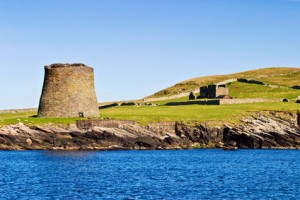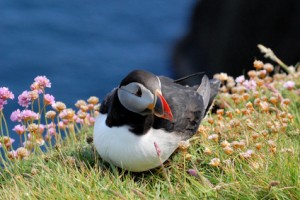The unspoilt landscape of Shetland has a rugged beauty shaped by the sea at the end of the last Ice Age.
Nowhere in Shetland is more than 3 miles from the sea and along the 1,697 miles of coastline you will find some of Britain’s highest cliffs, sea caves, sandy bays and beaches and even salt marshes.
There are few trees in Shetland so you really can see ‘as far as the eye can see’!
Shetland’s history reaches back many thousands of years and with more than 6,000 archaeological sites, much can be discovered about some of the previous occupants of these islands.
 Jarlshof is a multi period settlement complex which was in use from the Bronze Age until the 19th Century.
Jarlshof is a multi period settlement complex which was in use from the Bronze Age until the 19th Century.
The Iron Age in Shetland saw as many as 100 brochs, or towers, being built.
Some of these can be seen at Clickimin in Lerwick and also at Old Scatness, a major archaeological dig, rich in artefacts. The finest surviving example of an Iron Age Broch is Mousa Broch, on the island of Mousa, and standing at 13 metres tall, it is also the tallest.
 Vikings played a huge part in Shetland’s history – they began arriving around 800AD and stayed for 600 years.
Vikings played a huge part in Shetland’s history – they began arriving around 800AD and stayed for 600 years.
Europe’s finest example of a sand tombolo links the mainland to St Ninian’s Isle, where Norse Silver was discovered under a cross-marked slab in the early St Ninian’s Church. The remains of the chapel can still be seen on the island.
Reminders of the Viking warriors remain in place names such as St Olaf Street.
Europe’s largest annual fire festival, Up Helly Aa, takes place each January and you can watch the Viking Jarl squad parade through Lerwick with burning torches before setting alight the replica longship.
There are several museums worth a visit.
The Shetland Museum and Archives in Lerwick has displays on everything from Shetland’s geological beginnings to present day. Here you can see the clothing of the 17th Century Gunnister Man, who was discovered in a peat bog in 1951.
Lerwick, Shetland’s main town, is a busy seaport and is the hub of the cultural and social life in Shetland.
Music is at the heart of Shetland and although there are any festivals throughout the year, these three are the most prominent.
Shetland Folk Festival – The Rough Guide to Scotland 2006 placed the festival in the top 10 visitor attractions in Scotland.
Accordion and Fiddle Festival – 4 day festival attracts musicians from around the world.
Shetland Fiddle Frenzy – a must for all fans of traditional music.
 Shetland’s varied landscape is home to thousands of seabirds, as well as otters, whales and other wildlife.
Shetland’s varied landscape is home to thousands of seabirds, as well as otters, whales and other wildlife.
At Sumburgh Head, you can see one of the most accessible seabird colonies in the UK, and puffins can be seen here.
Shetland has 3 National Nature Reserves at Noss, Hermaness and The Keen of Hamar, Unst.
Noss is one of the most famous seabird colonies in the UK, with 180 metre high cliffs and inland heaths and bogs home to many species of birds.
Hermaness, on the island of Unst, is the most northerly headland in the UK and hosts one of Europe’s most important seabird colonies.
At the Keen of Hamar, you will find a barren moonscape dotted with rare plants, including the only Edmonston’s chickweed in the world.
Common seals are often spotted on a walk along the many miles of coastline, and if you look out to sea, you may spot one of the 20 species of whales and dolphins recorded in Shetland’s waters.
